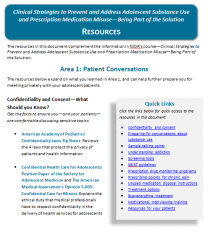
Getting Started
This course no longer offers continuing education credit. However, you can still view the course content by clicking on the Start the Course button below.
Please see below for more information about the course.
- Course Overview
Target Audience
This activity has been designed to meet the educational needs of clinicians including, physicians, physician assistants, nurse practitioners, nurses, and dentists/oral maxillofacial surgeons, involved in the care of adolescent patients.
Educational Objectives
After completing this activity, the participant should be better able to:
Part 1
- Describe the prevalence of substance use and prescription drug misuse among adolescents
- Explain why adolescents are at high risk of developing a substance use disorder and how clinicians can help prevent it
- Demonstrate strategies to build trust with adolescent patients and ensure confidentiality when addressing substance use and prescription drug misuse
- Summarize ways to identify substance use and prescription drug misuse in adolescent patients, including determining their level of risk
Part 2
- Discuss strategies to address substance use and prescription drug misuse in adolescent patients based on their level of use
- Summarize when and how to follow up with adolescent patients who use substances or misuse prescription drugs
Education Coalition
This activity was developed by an education Coalition of experts and medical professional organization representatives. The Coalition comprises the following organizations and experts:
Type of Reviewer: Organization/ Expert Consultant Reviewer Name California Academy of Family Physicians (CAFP) Cynthia Kear, Senior Vice President American Society of Addiction Medicine (ASAM) Jennifer Butchart, Education Coordinator
Penny Mills, Executive Vice President / CEO
Arlene Deverman, VP Professional DevelopmentAmerican Osteopathic Association (AOA) Stephanie Townsell, Director, Public Health
Marla Kushner, DOAmerican Association of Nurse Practitioners (AANP) Anne Norman, DNP, APRN, FNP-C, FAANP, Vice President of Education and Accreditation American Academy of Pediatrics (AAP) Renee Jarrett, Manager, Mental Health and Foster Care Initiatives
Div of Developmental Pediatrics and Preventive ServicesAmerican Academy of Physician Assistants (AAPA) Daniel Pace, Vice President, Education
Marie-Michele Leger, MPH, PA-C, Director, Clinical Education
Sara Evans, PMP, Project Manager, Quality Improvement InitiativesAmerican Association of Oral and Maxillofacial Surgeons (AAOMS) Vincent DiFabio, DDS Consultant Samantha Mattiucci, PharmD, Director of Medical Education Consultant Jan Schultz, BSN, MSN, RN, CCMEP, Director of Education Outcomes and Accreditation Services Consultant Dan Alford, MD, Associate Professor of Medicine, Assistant Dean and Program Director of the Addiction Medicine Residency program at Boston University School of Medicine Consultant Sharon Levy, Director, Adolescent Substance Abuse Program (ASAP)Assistant Professor in Pediatrics, Boston Children's Hospital Consultant Jeff Baxter, MD, Assistant Professor
Department of Family Medicine and Community Health, University of Massachusetts Medical SchoolConsultant Marc Fishman, MD Consultant Carol Havens, MD - Media
Internet activity
Disclosure of Unlabeled Use
This educational activity may contain discussion of published and/or investigational uses of agents that are not indicated by the FDA. The planners of this activity do not recommend the use of any agent outside of the labeled indications.
The opinions expressed in the educational activity are those of the faculty and do not necessarily represent the views of the planners. Please refer to the official prescribing information for each product for discussion of approved indications, contraindications, and warnings.
Disclaimer
Participants have an implied responsibility to use the newly acquired information to enhance patient outcomes and their own professional development. The information presented in this activity is not meant to serve as a guideline for patient management. Any procedures, medications, or other courses of diagnosis or treatment discussed or suggested in this activity should not be used by clinicians without evaluation of their patient’s conditions and possible contraindications and/or dangers in use, review of any applicable manufacturer’s product information, and comparison with recommendations of other authorities.
